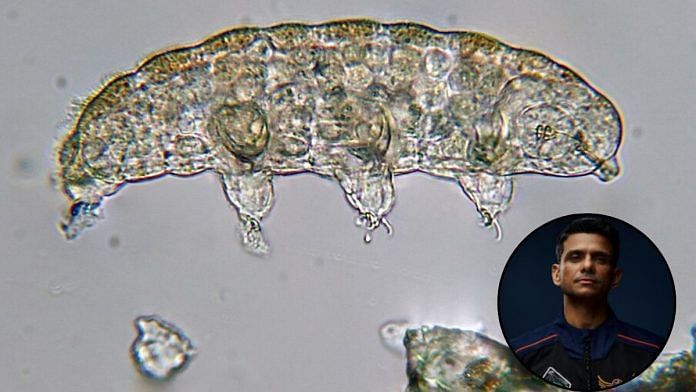New Delhi: Group Captain Shubhanshu Shukla is expected to return to Earth on 14 July, according to NASA. Shukla will arrive with the results of many important experiments he conducted in space, including those on microgravity. He will also return with the samples he had carried from different research institutes in India.
From the Indian Institute of Science (IISc) Bengaluru, Shukla had taken an organism about half a millimetre in size—the Tardigrade, popularly known as Water Bears. They are known to thrive in extreme heat and cold, deep inside the ocean, even in volcanoes and radioactive environments.
When the AXIOM-4 returns, scientists in India will study the results of Shukla’s experiments in space. The results are expected to provide information for Indian human spaceflight programmes in future, which include the Gaganyaan series and more, planned later in 2025 and in 2026. Specifically, the experiments will provide data on human health in space.
The Tardigrade experiment is expected to look into the potential of long-term space travel. Before the journey, the Tardigrades were put into hibernation, a period during which they require no food and their metabolic rate goes down to zero. In space, at the International Space Station, astronauts will try to revive them with water. If they can be revived, it will show that a journey in hibernation is possible, at least in simple life forms.
Scientists say that, ultimately, the information will be useful for long space travel, assuming that the same analogy works in higher animals.
Also read: Space farming to muscle regeneration, 7 experiments by Indian institutes to blast-off on Axiom-4
From Lab Lullaby to Space Wakeup Call
In the lab, the Tardigrades are grown in water. Before they were sent to space, the water was removed. In space, the astronauts will add water to the petri dish multiple times. Under the microscope, when and if the Tardigrade wakes up, the astronaut will capture videos as evidence of revival. Even the slightest movement will be enough to show that the Tardigrades can be sent and revived in microgravity conditions.
After this, the Tardigrades will be sent back into hibernation for the journey back to Earth, where scientists will take over the revival process. Tardigrades usually hibernate up to four months, according to scientists. But the duration of dormancy depends on the health of the particular micro-organism. Experts say that the chance of these Tardigrades waking up after hibernation depends its duration—the longer the hibernation, the fewer the chances of waking up.
The Tiny and Mighty
In 2022, molecular biologist Thomas Boothby, University of Wyoming, found that Tardigrades can survive despite extreme dehydration. Most organisms use a sugar called trehalose to save themselves from drying out. Tardigrades have only tiny amounts of these sugar molecules. Yet, they survive by using a unique protein.
Boothby and his team reported the results in the nature journal Communications Biology.
The unique protein called Cytoplasmic Abundant Heat Soluble (CAHS) proteins work together with trehalose to give better protection against dehydration. It’s a team game, according to Boothby, as the proteins don’t work without the presence of trehalose.
Since then, researchers have explored the potential of Tardigrade experiments to find solutions to water scarcity. However, scientists say that this is a long-sought research and there is still is a long way before tests can be carried out on humans.
Boothby’s research sparked interest among NASA officials and received support to carry out the water bear research. In a NASA podcast, Boothby said Tardigrade research might help astronauts stay healthier in space. In 2021 itself Boothby and his team sequenced the genome of the tardigrade Hypsibius exemplaris. The work was to understand how different environmental conditions affect these water bears.
(Edited by Viny Mishra)






